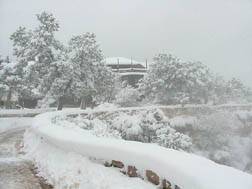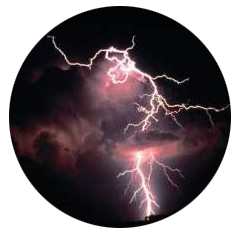|
Natural or Man-Made Icing?

One winter morning in a Mid-Western city, a multi-car pile-up
occurred on an interstate bridge. The direct cause was a
formation of ice on the bridge. Claimants alleged that the ice
had been created from nearby natural draft cooling towers
belonging to an industrial facility.
Research and onsite investigation, plus analysis of low- and
upper-level weather conditions by Meteorological Evaluation
Services meteorologists, determined
that the winds during that morning could not have taken the
effluent from the cooling tower in the direction of the bridge.
Further investigation of the weather data revealed that fog and
sub-freezing conditions early that morning were responsible for
the ice formation, and that the meteorological principle,
"bridge freezes first," was applicable in this instance. MES
documented the weather conditions and conclusions in a report.
Negligence or an ongoing snowstorm?

A slip
and fall incident occurred at 6 AM. Using certified
weather records, MES determined that all snow ended 72 hours
prior to the incident. There was no additional precipitation.
Hourly weather records showed that there were 4 inches of snow
on the ground at 8 AM on the morning preceding the incident.
Temperatures that day reached 39 degrees, before falling below
freezing during the night. Therefore, MES determined that there
may have been ice on the pavement due to the melting and refreezing of the
snow cover.
Lightning or Arson?

A factory burned to the ground on a July evening. The cause of
the fire was unknown. However, the nearest airport recorded a
thunderstorm in the vicinity near the time of the incident. MES
used weather radar records and lightning data to determine that
no cloud-to-ground lightning strikes occurred at the location
or in the vicinity
and estimated time of the fire. Therefore, lightning
did not cause the fire.
Natural or Spill-Induced Fog?

On a damp day with intermittent precipitation and fog, a
multi-vehicle chain reaction accident occurred on a rural
section of interstate highway. Industrial facilities bordered
the service roads. Just prior to the incident, a tanker truck
was overfilled with liquid nitrogen and a spill resulted.
Onsite meteorological data from an adjacent industrial facility,
specifically, ambient dry bulb and dew point temperatures, wind
direction, speed and stability pointed to the spill as the
source of the dense fog that engulfed the interstate highway
without warning. The National Weather Service airport and
Cooperative station data confirmed the dispersion
characteristics and calculations performed with the onsite data.
Act of God or Faulty Construction?
A retaining wall collapsed, destroying a frequently used
commuter railroad track. The incident took place 10 days after
a blizzard left over a foot of snow in the area. Conditions
before the blizzard were dry. Significant rain in the 6 hours
preceding the incident resulted in melting of the remaining snow
pack. Using past weather records, MES determined the maximum
water content in the melted snow pack. Coupled with the
precipitation, the amount of runoff for the 6-hour event was
equivalent to a 6-hour rain event with a maximum return period
of 8.6 years at that location. Therefore, the retaining wall
should have supported this runoff without a problem.
Printer-Friendly Forensics Brochure

|